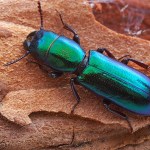Nature
This velvety worm-like creature may not look like a beetle, but it is. Beetles are like butterflies, passing through a complex metamorphosis on the way to adulthood, and this insect is the larval stage of a soldier beetle.
photo details:
Canon EOS 50D camera
Canon MP-E 65mm 1-5x macro lens
ISO 100, f/13, 1/250sec
tags: Koralle, Senckenberg Naturmuseum, museums, Frankfurt am Main, Germany, travel, nature, cities, image of the day, photography
Koralle.
Senckenberg Naturmuseum, Frankfurt am Main, Germany.
Image: GrrlScientist, 13 April 2010 [larger view]
Brain coral is a common name given to corals in the family Faviidae, so called due to their generally spheroid shape and grooved surface which resembles an animal brain. Each head of coral is formed by a colony of genetically identical polyps which secrete a hard skeleton of calcium carbonate; this makes them important coral reef builders like other…
tags: Glowing Life in an Underwater World, marine biology, bioluminescence, luciferase, luciferin, green fluorescent protein, eye-in-the-sea cam, ethology, evolution, Edith Widder, TEDTalks, streaming video
Some 80 to 90 percent of undersea creatures make light -- and we know very little about how or why. Bioluminescence expert Edith Widder explores this glowing, sparkling, luminous world, sharing glorious images and insight into the unseen depths (and brights) of the ocean.
TEDTalks is a daily video podcast of the best talks and performances from the TED Conference, where the world's…
tags: Koprolithen, Senckenberg Naturmuseum, museums, Frankfurt am Main, Germany, travel, fossils, paleontology, image of the day, photography
Koprolithen.
Senckenberg Naturmuseum, Frankfurt am Main, Germany.
Image: GrrlScientist, 13 April 2010 [larger view]
tags: Sonnenuntergang, Frankfurt am Main, Germany, travel, nature, sunset, photography
Sonnenuntergang.
Frankfurt am Main, Germany.
Image: Bob O'Hara, 20 April 2010 [larger view]
Sunset over Frankfurt, as photographed from the bedroom window. This sunset was influenced by the Icelandic volcano, Eyjafjallajökull. The light gold above the sun is a real cloud, but the darker haze surrounding the sun is the ash cloud. This ash cloud made the sun look fuzzy and at times, almost completely obscured it.
Today, the sky cleared for a few hours and everything seemed normal once more, but in the…
tags: Fledermaus Hologramm, Senckenberg Naturmuseum, museums, Frankfurt am Main, Germany, travel, fossils, paleontology, image of the day, photography
Fledermaus Hologramm.
Senckenberg Naturmuseum, Frankfurt am Main, Germany.
Image: GrrlScientist, 13 April 2010 [larger view]
Forget the heavy pro-grade camera gear for a moment. This shot was taken with a $300 Panasonic Lumix DMC-ZS3 digicam. These small cameras do wide-angle macro exceptionally well, and their tiny sensors and lenses give them a small-world perspective that SLR cameras struggle to replicate. Here, I placed the camera on the ground underneath a foot-high canopy of mayapples.
tags: Every Pollen Grain has a Story, pollen, microscopy, forensics, pollen signature, pollen fingerprint, science, Bosnian war crimes, pollinology, Jonathan Drori, TEDTalks, streaming video
Pollen goes unnoticed by most of us, except when hay fever strikes. But microscopes reveal it comes in stunning colors and shapes -- and travels remarkably well. Jonathan Drori gives an up-close glimpse of these fascinating flecks of plant courtship.
TEDTalks is a daily video podcast of the best talks and performances from the TED Conference, where the world's leading thinkers and doers give the talk of…
tags: Watch a National Geographic Bird Illustrator at Work, field guides, books, bird art, illustrator, National Geographic, Jonathan Alderfer, streaming video
See harlequin ducks come alive on paper in this time-lapse video featuring National Geographic bird expert and illustrator Jonathan Alderfer.
tags: Sonnenuntergang, Frankfurt am Main, Germany, travel, nature, sunset, photography
Sonnenuntergang.
Frankfurt am Main, Germany.
Image: Bob O'Hara, 19 April 2010 [larger view]
Sunset over Frankfurt, as photographed from the bedroom window. This sunset was influenced by the Icelandic volcano, Eyjafjallajökull. The clouds that you see are fluffy and a light gold color, the ash cloud is hazy and dark and (dare I say it?) menacing.
The haze from the Icelandic volcano is much worse today than it has been ever since Eyjafjallajökull first blew. I know that the airlines want to start flying…
tags: Koralle, Senckenberg Naturmuseum, museums, Frankfurt am Main, Germany, travel, fossils, paleontology, image of the day, photography
Koralle.
Senckenberg Naturmuseum, Frankfurt am Main, Germany.
Image: GrrlScientist, 13 April 2010 [larger view]
This is another beautiful coral that I photographed recently at the Senckenberg Naturmuseum. If you were here today, I would unfortunately opt to show you photographs instead of venturing out into the volcanic ash. However, if you were here, you and I would recall the Mt St Helens explosion over cold beers, and we would look at the jar of…
tags: Sonnenuntergang, Frankfurt am Main, Germany, travel, nature, sunset, photography
Sonnenuntergang.
Frankfurt am Main, Germany.
Image: Bob O'Hara, 18 April 2010 [larger view]
Sunset over Frankfurt, as photographed from the bedroom window. This sunset was influenced by the Icelandic volcano, Eyjafjallajökull.
This is probably the last sunset photograph you'll see from Frankfurt that doesn't have a dozen or more (disgustingly ugly!!) contrails messing it up because the latest news is that the eruptions from the Icelandic volcano are slowing down .. and there are some EU flights…
Polistes dominula, the European Paper Wasp
captured with an iPhone
As an insect guy, the first question I ask about any camera is: Can I shoot bugs with it?
To my great disappointment, the answer for most cell phones is no. Cell phone cameras are normally fixed to focus at distances useful for party pictures and street shots. Fixed-focus simplifies the mechanics of the onboard camera, but it also makes close-ups of small subjects impossible. Even Apple's iPhone 3GS- which has variable focus- doesn't focus quite closely enough do anything but the largest insects. So when an aphid plague…
tags: Fels, Senckenberg Naturmuseum, museums, Frankfurt am Main, Germany, travel, nature, cities, image of the day, photography
Fels.
Senckenberg Naturmuseum, Frankfurt am Main, Germany.
Image: GrrlScientist, 13 April 2010 [larger view]
This is a close look at a large rock standing on the grassy traffic island in front of the Senckenberg Naturmuseum. The grain shows how tortured this rock was when it was still soft.
tags: Versteinerung Muschelschale, Senckenberg Naturmuseum, museums, Frankfurt am Main, Germany, travel, nature, cities, image of the day, photography
Versteinerung Muschelschale.
Senckenberg Naturmuseum, Frankfurt am Main, Germany.
Image: GrrlScientist, 13 April 2010 [larger view]
This is a gorgeous fossil shell photographed at the Senckenberg Naturmuseum .. how old is this? What species is this? I don't know .. but I will return and collect more detailed information to share with you (this first visit was a quick pass through the museum to see what they have on display).
Philothermus glabriculus (Cerylonidae)
Urbana, Illinois
A while back I noted that, at a rate of one beetle per week, I'd need about 10,000 years to get through all the described species. Since I made that comment we're getting closer to needing only 9,999 years, but if the Coleopterists keep discovering new ones I'm not sure what I'll do*. There are an awful lot of beetles.
In any case, this little Cerylonid is common under the bark of dead trees across eastern North America. Its diminutive size (only a couple millimeters long) makes it rather difficult to spot, so to find Philothermus you'…
tags: Koralle, Senckenberg Naturmuseum, museums, Frankfurt am Main, Germany, travel, nature, cities, image of the day
Koralle.
Senckenberg Naturmuseum, Frankfurt am Main, Germany.
Image: GrrlScientist, 13 April 2010 [larger view]
If you were here today, I would show you around the Senckenberg Natural History Museum. During your visit, this is one of the many natural wonders you would see.
...for no reason other than that I need something sparkly this morning.
Temnoscheila sp. bark-gnawing beetle, Trogossitidae
Tucson, Arizona
The reflective integument makes this beetle a real trick to shoot. It's like trying to photograph a mirror- a regular flash either reflects back at full, blown-out glare or not at all. So I shot this beetle in a white box, where the soft, even lighting can bathe the insect without sharp hightlights or deep shadows.
photo details:
Canon EOS 20D camera
Canon MP-E 65mm 1-5x macro lens
ISO 100, f/14, 1/250sec
What was that inexplicable bit of chitin hiding away in a hole in a twig?
This photo should help:
It's the heavily sclerotized head shield of a Cephalotes varians turtle ant. Ants in this mostly Neotropical genus inhabit pre-existing cavities in trees and branches, a limiting resource that spurs intense competition among colonies of various tree-dwelling species. Workers come in two size classes: small and relatively lithe, and tank-like with a dinner plate for a head.
Turtle ants aren't fighters. Rather, they're all about defense. If a colony gets hold of an old beetle burrow, the heavily…
The winners of the NCSU insect blog Hexapod Haiku Challenge have been announced. Here's the best in show:
Major, Undeclared
Silverfish, tell me,
Darwin and Dostoevsky,
do they taste the same?
-Martha Love
Gastonia, NC
Ha! I love it.




